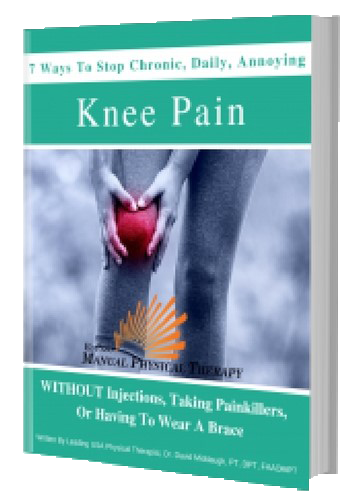TAP TO CALL (915) 503-1314

HOW LONG DO NERVE ENDINGS TAKE TO HEAL AFTER KNEE REPLACEMENT SURGERY?
How long do nerve endings take to heal after having knee replacement surgery? Well, there’s a nerve that goes right on the front of the knee, called the infrapatellar branch of the saphenous nerve, that nerve must be severed and must be cut in order for the surgeon to get in and perform the knee replacement surgery.
Luckily, that nerves main purpose is sensation to the area to the skin, the tendons of the things in the area, and not muscles, that means that you shouldn’t lose muscle function. That’s why the surgeons decided to go in this way. And let’s talk expectations with nerve pain after having a knee replacement.
Most surgeons are expecting you to heal normally within about six months to 12 months after having a knee replacement surgery and they’re expecting that nerve to reconnect and for the sensation to normalize about in that timeframe six to 12 months after having the knee replacement surgery.
Now early on in the recovery after surgery, everything’s going to be injured the you’re going to have stitches in the area, the incision is going to be closing up. But within about two to three months, you should have the stitches gone or staples that they use that or any other things that they use in terms of use just stereo strips or glue.
All of that should be gone. And you should be developing a nice scar, it’s in that timeframe about two to three months out that you can begin to decipher if you’ve got nerve pain related to your knee replacement, because prior to that, it’s hard to tell where exactly the pain is coming from as far as what tissue, you know, if it’s skin or muscle tendon ligament or the bone where it was cut to attach the metal parts to the bone to do the knee replacement.
The biggest deciphering factor in knowing that it’s nerve related pain is that the pain doesn’t really change once you go to put weight on it. If you’re lying down or sitting down and you experience pain in your knee, and then you go to stand up and the pain doesn’t really change, it’s about the same, then there’s a chance that that could be nerve pain related.
Whereas if you stand up and the pain goes away, or it comes on worse than that could be more related to the tendons ligaments, bones, the other mechanical structures, not the nerve, which isn’t considered a mechanical structure, it’s more of a controlling structure, sensation feedback structure.
Now let’s talk about problems that can cause chronic nerve pain after the knee replacements. In some patients, the healing doesn’t go as planned. And many will actually complain of numbness just below the kneecap off to the outside part of the knee. Sometimes it’s across the entire front of the knee.
But the most common sensation that people have is just numbness which technically isn’t pain, it’s just an odd sensation where if they touch the area right there, they can feel that there’s no sensation right there. And then they can actually feel their skin. Normally they rub it on the outside above or below or on the inside of their knee.
The next level of problems would be tingling in the area. Tingling is more like creepy crawlies or like something’s on your skin. And it’s also not necessarily pain, but it’s more of a discomfort and it may come and go or it may be more constant. The next level of discomfort could be hot or cold sensations.
Because the nerves are involved in temperature regulation, as well as the sensation of the temperature, which are two different things, you might get the sensation that there’s heat coming in the area or a cold coming in the area, even though your skin temperature feels the same. Or you might actually even get a skin temperature change where it feels really hot or really cold in the area.
Both of those situations could be related to nerve pain. The next one is getting achiness right in that same area. Achiness is like a low level of pain that can flare up over time. But it’s more of a lingering pain and it’s hard to pinpoint.
Usually it’s over an area. And it’s uncomfortable, it may still be there at night when you go to lay down to go to bed. And it doesn’t change when you get up and walk.
Although if you’re doing some repetitive motion like walking or some exercise where you’re repeatedly bending your knee, it could make an achiness increase in intensity and severity than if the nerve pain gets even worse, you might start to get sharp, stabbing like pain, that usually doesn’t linger around, but it stops you in your tracks.
It might stop you from doing something, you might not be able to stand up or sit down and you might just not be able to bear weight and a leg for a while. And then it gradually begins to go away and may reduce to an ache that is still painful. If you go to the doctor for this type of problem. If you go back to your surgeon, that’s what you people usually will do.
The surgeon of course is going to take x rays or some sort of imaging tests to look and make sure that the surgery is intact, but there’s nothing wrong with the surgery. They’re looking to make sure that the metal parts are in place and they haven’t loosened and that the alignment is where it’s supposed to be. And very often if it’s just a nerve problem, the surgeon will say something to you like there’s nothing wrong with your knee.
The knee replacements normal everything’s fine. And if they don’t explain a bit more realize that what they mean is that there’s nothing wrong with the metal parts of the alignment the stuff that I’m talking about, but what they maybe are not communicating. So do communicate it. But some don’ts as well is that you have another problem.
That’s a side effect of the surgery, which is the nerve damage. And some will bring it up to you and say you probably have nerve pain because I cut the saphenous nerve or the infrapatellar branch of the saphenous nerve, and they may begin to offer you medications for this. The most common nerve medications that they might offer are Gabapentin and Lyrica.
And you can use this as a test. If you take these medications and find that the pain improves, then that’s evidence that you have a nerve pain. And then you can even get more pinpointed if you’ve tried Tylenol or ibuprofen. And it didn’t really affect the nerve problem, then that’s probably a nerve pain.
Because ibuprofen and Tylenol don’t usually help nerve pain, they help things like tendons, ligaments, skin, other tissues can be improved with Tylenol and ibuprofen. In most cases, nerve pain from the surgery can be improved. But I do have to give a disclaimer, it’s possible that it may never go away, it may still be there on a low level, you may just get the numbness, that’s a nice situation to be in. If you don’t, if you had pain, you can at least get rid of the pain.
But you may have lingering problems from the nerve being severed forever indefinitely. But the way that you can help it is by getting more mobility in the knee, it could be that you’d lack actual range of motion the knee or the skin and the tissues under the skin like the fascia, the fat, we have different layers of tissues right under the knee right here that may not be moving well together. And that could be getting that nerve stuck.
It could also be it’s possible that the nerve where the incision was made, had to heal like this, instead of like this. And if that’s the case, you’re just going to likely have problems. And it’s difficult to know that for sure. Unless you open yourself up and look inside again, are you a surgeon, we have to do that. But that of course is putting you at risk for even more problems, you’re better off dealing with the situation that you have and improving it.
Another factor to consider that surgeons rarely ever mentioned is the entire nerve pathway needs to be looked at in order to make sure that the problem isn’t coming from somewhere else, that saphenous nerve that sends that infrapatellar branch across the front of the nerve starts up in the lower back, it comes off the spine, then runs into the hip down the thigh and all the way down into the lower leg and even into the arch of the foot.
So you need to look at the foot, of course the knee, the hip, and even the back. A thorough analysis of all these body parts is what we do here to make sure that we are addressing the nerve holistically.
I talked extensively about how to do this. And looking at new things that probably haven’t been looked at like muscle imbalance here on this channel in regards to totally replacement after effects. You can learn more about that through our playlist. I’ve linked it down in the description below. It’s called knee replacement help.
I’ve also got a program called the failed knee replacement program that goes extensively into how to address pain from a knee replacement, lingering chronic pain, and then correcting muscle imbalances that are the root of the problem so that you can get the best out of your knee replacement for the long term.
Hey, if this information was helpful for you, please give us a thumbs up that helps to get this video out to more people that need to see this. And if you can just share this video out on your social media or directly with somebody send a link to a friend email text however you however you like to send links that always helps to because you might be affecting their life for the better. And they’ll thank you for it.
And if you haven’t already, please subscribe and turn on our notifications so that you don’t miss out on any of the videos that we post each and every week. Thanks so much for watching. I’ll see you in the next video. Bye bye!
Would You Like To Talk With A Specialist?
Appointments and Questions Call: (915)503-1314
EL PASO MANUAL PHYSICAL THERAPY
2601 E. Yandell Drive, Suite 232
El Paso, Texas 79903
© 2023 El Paso Manual Physical Therapy, PLLC, All Rights Reserved
